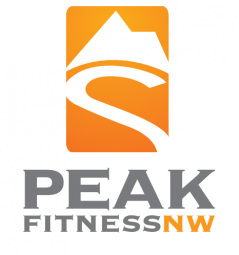Good skiing relies on the ability of the skier to rotate their femurs (big leg bones) in the hip sockets, while the upper body (pelvis, core & shoulders) remain relatively quiet. It is also important that each leg can rotate toward the middle line of the body and away from the body equally. If one side is tighter then the other it may limit your skiing efficiency. Today we are going to address the tightness of your external rotates of the femur (glutes, piriformis). Are yours tight?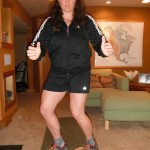
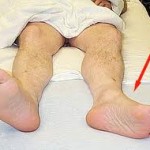 Tightness of the leg rotators can easily be checked at home. Lie down on your back, imagine you are lying on the sand and you’re relaxing every muscle in your body to leave an imprint of your body in the sand. Once relaxed look at, or better yet have someone else look at the direction your feet are pointing and are they equal? If you’re feet have dropped open into a “V” position your leg rotators may be tight and limiting your range with which you can rotate your legs inward and ultimately the steering and guiding of your skis.
Tightness of the leg rotators can easily be checked at home. Lie down on your back, imagine you are lying on the sand and you’re relaxing every muscle in your body to leave an imprint of your body in the sand. Once relaxed look at, or better yet have someone else look at the direction your feet are pointing and are they equal? If you’re feet have dropped open into a “V” position your leg rotators may be tight and limiting your range with which you can rotate your legs inward and ultimately the steering and guiding of your skis.
Proprioceptive neuromuscular facilitation is a great way to improve range of motion. Proprio…..WHAT? Let’s just call it PNF for short – is one method of facilitating flexibility and range of motion in healthy people…and athletes. Terminology you need to know to understand PNF:
2 Types of Muscle Contractions:
- Isotonic is a voluntary contraction that causes movement. Concentric or shortening of the muscle and eccentric or lengthening of the muscle by an outside force. Example: bringing your hands into a prayer position is a concentric isotonic contraction of the pectorals/chest muscles; pulling your hands apart from a prayer position is an eccentric isotonic contraction of the pectorals.
- Isometric is a voluntary concentric contraction in which no joint movement occurs and muscle length is unchanged. Example: Squeezing your hands against each other in prayer position is an isometric contraction of the pectoral muscles.
Stretch reflexes are automatic responses designed to protect the body and a play a role in PNF.
- Myotatic stretch reflex prevents a muscle from stretching too far too fast, which protects the joint from injury. Briefly, when a muscle lengthens too quickly a reflex occurs causing the muscle to contract, resisting the lengthening and preventing overstretching of the joint.
- Inverse stretch reflex inhibits, or relaxes a muscle. When a muscle is maximally contracted and develops strain in the tendon an inverse stretch reflex should cause the muscle to relax. Also, when a muscle stretch is held and places a pull on the tendon the muscle will then relax and lengthen further to reduce the chance of a muscle tearing.
Sherrington’s Laws (Charles Sherrington research in the early to mid-1900s helped develop a model for how the neuromuscular system operates)
- Successive induction is the isometric or isotonic contraction of one muscle, followed immediately by the contraction of its antagonist, the opposing muscle).
- Reciprocal innervations is a reflex loop that causes one muscle to relax (inhibited from contracting) when the opposing muscle (the antagonist) contracts.
- Irradiation occurs when a maximal contraction of the muscle is achieved by applying resistance.
Two types of PNF stretching will be explained and demonstrated below. These types of PNF stretching usually requires two people – the stretcher and partner, however you can perform them yourself:
Contract-Relax is appropriate for those with good range of motion is and are pain-free.
- The partner provides resistance as the stretcher isometrically attempts to move the limb into the shortened range of the target muscle.
- Stretcher then relaxes, and the limb is moved passively into the new range by the partner.
CRAC, contract-relax, antagonist-contract, has been found to be the most effective in achieving gains in range of motion and safest.
- Performed same as contract-relax.
- After the isometric contraction (irradiation), the stretcher actively moves the limb (reciprocal inhibition – one muscle relaxes while the opposing muscle contracts) into the new range of motion (deeper stretch)
Today you’ll learn how to perform Contract-Relax and CRAC to stretch the piriformis/gluteal muscles to enhance flexibility and leg rotation for skiing. It is important to understand that PNF stretching for one muscle is valuable for developing flexibility and should be used, with a regular stretching program, to make quick gains in range of motion.
Contract – Relax – Antagonist Contract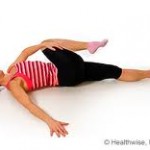
- Stretcher begins lying on their back
- Flex the hip and knee, pulling the knee toward the opposite shoulder
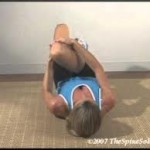
- Non-stretching leg is straight
- Places hand(s) on the stretcher’s lateral/outside knee to provide resistance for isometric contraction
- Stretcher pushes knee diagonally into hands and away from opposite shoulder, isometrically contracting the piriformis/gluteals for 6 seconds. Stretcher begins contracting 50% and builds to 100% (irradiation); remember to breath!
- Stretcher relaxes, after 6 seconds; inhales deeply and pulls the knee to the opposite shoulder by isotonically contracting the hip flexors and adductors (antagonists) to deepen the piriformis stretch (inverse stretch reflex).
- Gently place hands on outside of knee and pull toward the opposite shoulder to deepen the stretch.
- Repeat 3-5 times/each side.
Guidelines: These stretches should be pain-free. If there is pain – attempt to reposition the leg and begin again and/or stop performing the stretch until the cause of pain is determined.
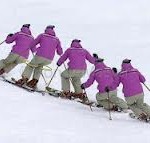 Effective and efficient leg rotation is essential to great skiing. PNF stretching should be included in a regular conditioning and stretching program to further enhance flexibility and range of motion. My soon to be released 12-week PEAK Ski Conditioning program will include more PNF stretching for commonly tight muscles in skiers.
Effective and efficient leg rotation is essential to great skiing. PNF stretching should be included in a regular conditioning and stretching program to further enhance flexibility and range of motion. My soon to be released 12-week PEAK Ski Conditioning program will include more PNF stretching for commonly tight muscles in skiers.
Receive new ski, fitness, health and nutrition tips weekly by sharing your name and email with me to the right side of this blog! New PEAK fitness NW Ski Conditioning programs are beginning, in the Portland Metro area, on Monday, July 8th and Thursday, July 11th! Go to www.peakfitnessnw.com/events for more information on the July/August 2 for 1 SPECIAL!
